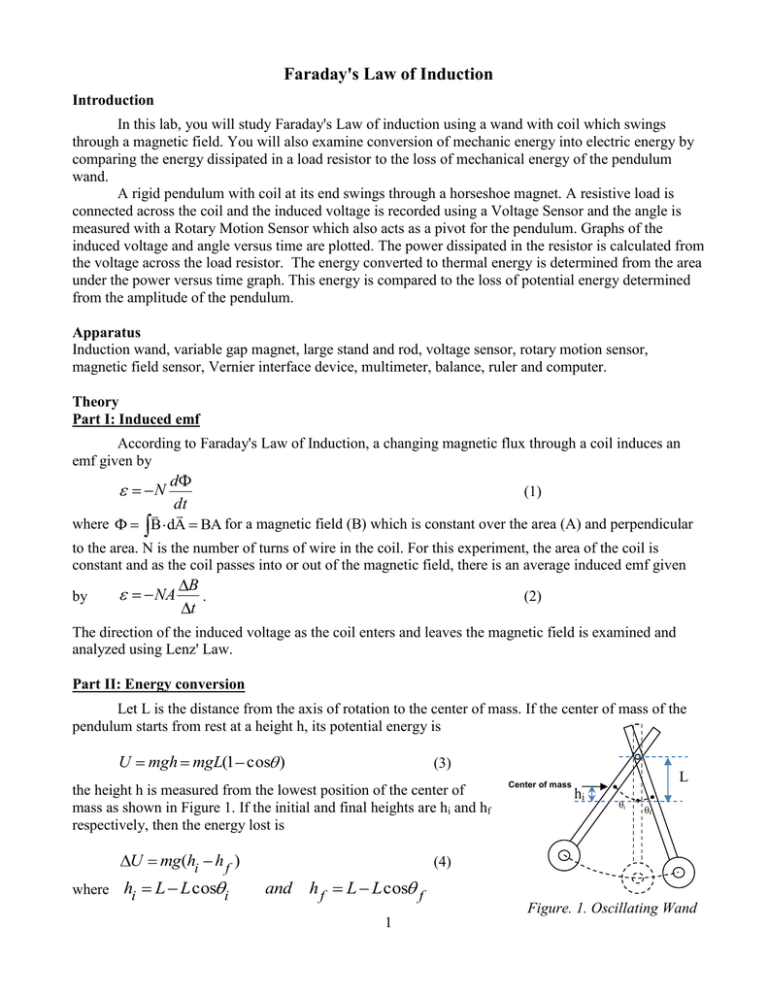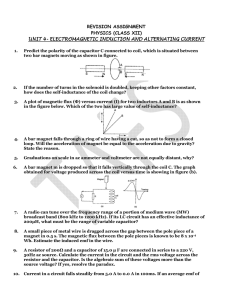Faraday`s Law of Induction
advertisement

Faraday's Law of Induction Introduction In this lab, you will study Faraday's Law of induction using a wand with coil which swings through a magnetic field. You will also examine conversion of mechanic energy into electric energy by comparing the energy dissipated in a load resistor to the loss of mechanical energy of the pendulum wand. A rigid pendulum with coil at its end swings through a horseshoe magnet. A resistive load is connected across the coil and the induced voltage is recorded using a Voltage Sensor and the angle is measured with a Rotary Motion Sensor which also acts as a pivot for the pendulum. Graphs of the induced voltage and angle versus time are plotted. The power dissipated in the resistor is calculated from the voltage across the load resistor. The energy converted to thermal energy is determined from the area under the power versus time graph. This energy is compared to the loss of potential energy determined from the amplitude of the pendulum. Apparatus Induction wand, variable gap magnet, large stand and rod, voltage sensor, rotary motion sensor, magnetic field sensor, Vernier interface device, multimeter, balance, ruler and computer. Theory Part I: Induced emf According to Faraday's Law of Induction, a changing magnetic flux through a coil induces an emf given by N where d dt (1) B dA BA for a magnetic field (B) which is constant over the area (A) and perpendicular to the area. N is the number of turns of wire in the coil. For this experiment, the area of the coil is constant and as the coil passes into or out of the magnetic field, there is an average induced emf given NA by B . t (2) The direction of the induced voltage as the coil enters and leaves the magnetic field is examined and analyzed using Lenz' Law. Part II: Energy conversion Let L is the distance from the axis of rotation to the center of mass. If the center of mass of the pendulum starts from rest at a height h, its potential energy is U mgh mgL(1 cos ) (3) the height h is measured from the lowest position of the center of mass as shown in Figure 1. If the initial and final heights are hi and hf respectively, then the energy lost is U where hi mg(hi h f ) L L cos i Center of mass hi L ● ● θi ● θf (4) and h f L L cos f 1 Figure. 1. Oscillating Wand According to the conservation of energy, it will be equal to the energy lost to friction, and energy converted to electrical energy. For a resistive load in the circuit (R), the electrical energy is then dissipated as thermal energy. Induced emf ( in the circuit is IR Ir Coil r where r is the resistance of the coil itself, and I is the current in the circuit. Since R and r in series the power (P = I ) in circuit is given by P I 2 (R r) V R 2 (R r) (5) R where V is the voltage across the external resistor, V = IR. Figure. 2. Equivalent circuit diagram Thermal energy dissipated in the resistor (R) is given by E = P∙ t = Area under power (P) versus t graph. Procedure Before setting up the apparatus for this lab, measure the following and write down in a data sheet. a. The resistance of the coil of the induction wand (r) and the resistor attached in the banana plug (R) separately using a multimeter. b. Plug the banana plug with resistor to the end of the wand handle. Locate the center of mass of the wand. Measure the distance from the pivot point to the center of mass (L). c. Mass of the wand including the banana plug (m). d. Find the number of turns (N) and area of the coil (A) from the specification of the induction wand. Part I: Induced emf by moving coil In this part, the induction wand is swung into the magnetic field. The setup for this part is shown in the Figure 3. - Assemble the Rotary Motion Sensor with Rotary motion the stand. Attach the induction coil wand to sensor the Rotary Motion Sensor. - Adjust the height of the stand so that the coil is in the middle of the variable gap magnet. Voltage sensor Adjust the gap between the magnet poles to about 1 inch. Induction wand - Connect the voltage sensor terminals to the Magnet induction wand. [Make sure you are NOT measuring voltage across the load resistor if Magnet the banana plug is inserted!]. Drape the field voltage sensor wires over the rods as shown sensor in Figure 3 so the wires will not exert any Figure. 3. Experimental set up for part I torque on the coil as it swings. Plug the Voltage probe and Rotary Motion Sensor into the Vernier interface which should be connected to a computer. 2 - Now, Open Logger Pro in your computer. Set samplings rate to 1000 samples/sec and collection time to 20 sec. [You may click ‘Experiment’ and then ‘Data Collection’ in the menu bar to change the setting]. Before taking the data, zero the values by clicking at Ø. Now click ‘Collect’ with the coil at rest in its equilibrium position between the magnets. Then rotate the wand to some angle (For example i = 0.4 rad) and let it go. Click ‘STOP’ after a few swings. Analysis 1. Highlight the first induced voltage region and determine the average voltage. Write down the average voltage of the first peak in your data sheet. 2. Identify on the graph where the coil is entering the magnet and where the coil is leaving the magnet. Why is the sign of the emf of the second peak opposite to the sign of the first peak? 3. Why is the emf nearly zero when the coil is passing through the center of the magnet? Explain your answers and include the graphs of emf and angle vs time (in the same scale) in your lab report. Estimation of induced emf, - In order to estimate theoretical value, measure the magnetic field between the magnet poles using the magnetic field sensor (or use the value provided). Calculate maximum flux change. - From the graph, determine the difference in time from the beginning to the end of the first peak ( t). - Calculate the value of the average emf using Faraday’s equation and compare with your result. Part II: Mechanical to Electrical Energy Conversion For this part of the lab, the apparatus setup is shown in the Figure 4 below. First, you will measure the change in potential energy in open circuit condition to determine the energy lost due to friction and then change in potential energy in a closed circuit condition to determine the energy dissipated in the resistors. Figure. 4. Experimental set up for part II Figure.5. Resistor Disconnected 3 (a) Energy lost due to Friction - Adjust the gap between the magnet poles. Put the magnet poles as close together as possible but the wand should swing through the magnet without hitting it. - Plug the load resistor with one of its plugs out to the side and one plug in the wand (see Figure 5). It makes the circuit open without changing the center of mass. - Connect the voltage probe terminals across the load resistor (but the circuit is still open!). - Make sure the Rotary Motion Sensor probe is connected properly into the Vernier interface which should be connected to a computer. Measurement and Analysis - Before collecting the data, make sure the samplings rate is 1000 samples/sec and collection time is 20 sec. If not adjust them as you did before in part I. - Before taking the data, zero the values by clicking at Ø. Now click ‘Collect’ with the coil at rest in its equilibrium position between the magnets. Then rotate the wand to an initial angle (For example i = 0.4 rad) and let it go. Click ‘STOP’ after it has swung to the other side. Repeat the step if the first trial did not go well. - Determine the angle to which the pendulum rises after it passes once through the magnet. Potential Energy (U) versus time graph You can display a graph of the potential energy versus time from the data of angle you just measured from the rotary motion sensor. Follow the instructions given below On the computer, click “New Calculated Column’ under ‘Data’ menu. Name it ‘Potential Energy’ U as short name and ‘Joules’ in unit. Under the expression, type the right hand side expression of Eq. (3) as in any computer language. You may directly use the values for m, g, and L or use them as parameters and then substitute the values. For angle , click ‘Variables (Columns)’ and choose (angle). Click ‘Done’ to complete. - This will add a column for you with calculated potential energy values corresponding to the angles measured by the rotary motion sensor. Insert a new graph to display U versus t graph. Determine the energy lost due to friction from this graph and save the graph. You should include this graph in your report. (b) Energy dissipated by the load resistor - Now, reconnect the load resistor (R) with both plugs in the wand. This completes the series circuit of the load resistor and coil. Repeat the previous steps. Click ‘Collect’ with the coil at rest in its equilibrium position between the coils. Then rotate the wand to an initial angle ( i) and let it go. Make sure your initial angle ( i ) is same as in the previous swing in the open circuit case. Click ‘STOP’ after it has swung to the other side. 4 - Measure the angle to which the pendulum rises after it passes once through the magnet. Note the initial and final angles. Determine the potential energy lost from the U versus t graph. This is the total energy lost. So, how much is the energy dissipated by the resistor? In order to measure the energy dissipated by the resistor, add a ‘New Calculated Column’ and ‘Insert’ a new graph of Power (P) versus time (t). (Similar to U versus t, you just did). This time you are using eq. (5). - In the Power (P) versus time (t) graph, highlight both peaks and find the area (Integral value). Include this graph in your report. This area is the energy dissipated by the resistors. Why do you need to include two peaks? Add the energy dissipated by the resistor and the energy lost to friction. Compare this to the total energy lost by the pendulum. Questions: 1. What are the possible errors in this experiment? 2. Highlight the first induced voltage region and determine the average voltage. What is the average voltage of the first peak? Is it induced emf? 3. Why is the sign of the second voltage peak opposite to the sign of the first peak? 4. Why is the second peak voltage smaller than the first one? 5. Why is the voltage nearly zero when the coil is passing through the center of the magnet? 5

